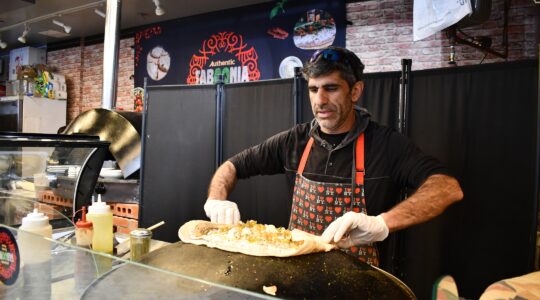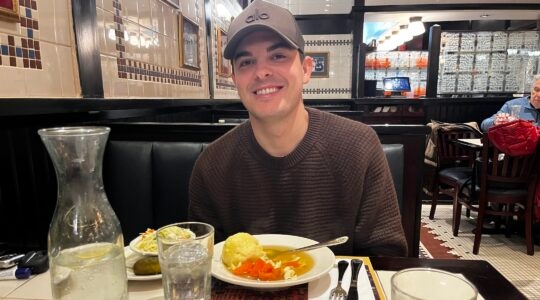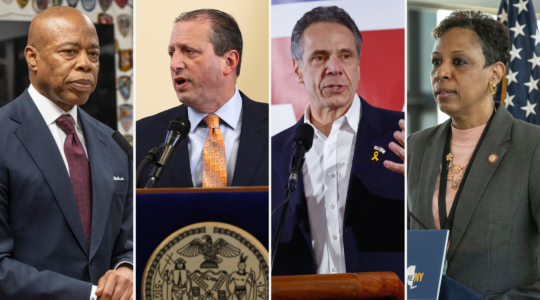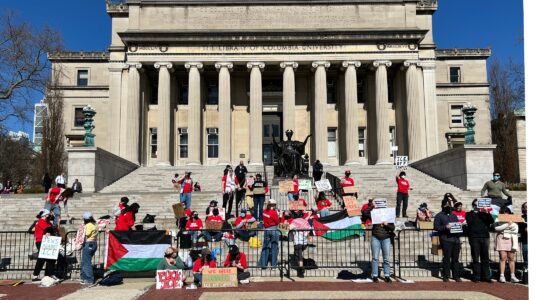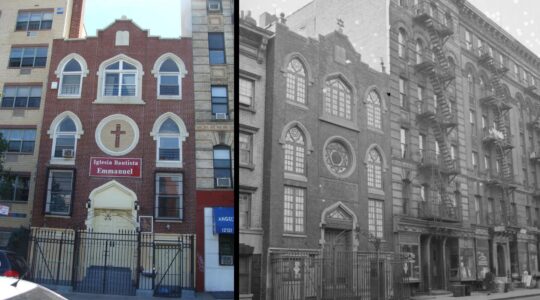In 1971, Ronald Brown visited Prague for the first time and was disturbed by what he saw at the famous 500-year-old Charles Bridge: a centuries-old crucifixion statue framed by one of Judaism’s most sacred prayers. The then-25-year-old rabbinical student at Hebrew Union College was upset by the symbolism of the Hebrew inscription in relation to the cross. The quote was taken from the prophet Isaiah ("Holy Holy Holy is the Lord of Hosts") which the angels chant to praise God, according to Jewish tradition. Jews say the phrase three times daily during the silent meditation, or Amidah.
But 17th century Czech officials employed it for another purpose: to punish and humiliate Jews for the alleged blasphemy committed by a Prague Jewish leader and to validate Christianity’s superiority. "It’s offensive," says Rabbi Brown. "It’s using Hebrew Scripture against ourselves to confirm the teaching of the Trinity."
The inscription has long been a source of dismay for Jewish tourists and the city’s small observant Jewish community, particularly as local guides retell various versions of the Jewish blasphemer legend, which Jewish researchers say is false.
Now, for the first time in 300 years, an effort is under way to resolve the issue, with the help of Rabbi Brown of Merrick, L.I., and a delegation from the newly founded North American Boards of Rabbis. Next month, Prague Jewish leaders and city and Czech officials are expected to meet to discuss placing an explanatory text alongside the statue to explain the true circumstances behind the placement of the Hebrew quotation at the W.E. Brohn gilt bronze statue bought in Dresden in 1657.
"My feeling is that there’s a good will on the side of City of Prague," said Leo Pavlat, director of the Jewish Museum in Prague, who with Chief Rabbi Ephraim Sidon has been negotiating for years with government agencies.
The initiative follows a trip in March to Prague by a NABOR delegation. The group was founded earlier this year by Rabbi Marc Schneier of the Hampton Synagogue on Long Island and president of the New York Board of Rabbis. Rabbi Brown, NABOR’s vice president, said the Prague trip, one of the first actions by the group, was conceived to help the Jews of Prague. The community is among the oldest in Europe and during the Middle Ages was the largest and most revered, serving as home to the illustrious Rabbi Judah Loew, creator of the legendary Golem. In 1939 there were more than 50,000 Jews in Prague; today there are 2,000, many fleeing during the Holocaust.
NABOR officials, who had discussed bringing up the statue with Czech officials during their trip, discovered that Prague Jews had also been trying to resolve the issue: with little success, Rabbi Brown said. Pavlat said feelings about the statute are mixed in the small Jewish community.
"Many of them are not religious and don’t understand Hebrew. I don’t think the inscription is perceived by them as something disturbing," he explained in an e-mail this week. "For local observant Jews [and] those who visit Prague as tourists, the inscription is indeed offending, reminding of the old anti-Jewish stereotypes of the Catholic Church." Local legend has it that a Jewish leader named Elias Backoffen blasphemed Christianity at the statue in 1693, and was found guilty during a fixed trial conducted by Prague’s Christian government officials. On March 20, 1694, Backoffen was fined 1,000 gold florins.
To punish the Jews, the Czech government on Sept. 13, 1696 added to the statue a gold Hebrew inscription, paid for with Backoffen’s fine. Following the NABOR trip, Rabbi Brown wrote to Prague Mayor Jan Kasl requesting that the offending inscription be removed.
"The Hebrew words do not belong there. Perhaps they belong in the Jewish museum," he wrote.
But the mayor and the office of national landmarks rejected the suggestion, citing the relic’s national landmark status. "The decoration of the Charles Bridge cannot be changed because the National Heritage Law excludes any such intervention," the mayor responded in a May 7 letter to Rabbi Brown. According to the State Monument Care Institute, the Charles Bridge "is among the most important monuments of both the City and the country. Currently it is in the highest category of monument protection."
Kasl did agree, however, to consider placing a plaque of explanation beneath the sculpture, according to his response to Rabbi Brown. On June 17, Pavlat sent a letter to Prague’s Monument Care Department proposing the text to be fixed beneath the crucifix. Two weeks later, the landmarks agency said it needed the exact text and other information before proceeding.
"I was promised that then there will be a meeting bringing together involved institutions (the Monument Care Department of the Prague Municipality, the State Monument Care Institute, the Gallery of the City of Prague, the Jewish Museum in Prague, the mayor of Prague and Rabbi Sidon) to solve all possible problems," Pavlat said.
Jewish researchers dispute the legend contained in Czech tour books and repeated by local guides. Pavlat explained that the true story 306 years ago revolved around a legal war between representatives of the Czech Jewish community. Rabbi Schneier said the explanatory plaque would be a major step. "To put this into context, this statue is like the Statute of Liberty for Czech citizenry," he said. "For any Jew who has been to been to Prague, this is a very big thing." Petr Gandalovic, the Polish general consul in New York who accompanied the NABOR group in March, said he is optimistic a solution can be reached.
"I understand it might be very damaging for Jewish people, just the fact that it’s been there for centuries," he told The Jewish Week Monday. "It’s better to get together and find a way how these things can be explained to the general public to avoid misunderstandings and sensational explanations from tourist guides." But he said it is also important to insure that the general population of Prague is not offended by any changes to its historic bridge. Gandalovic and Pavlat credit NABOR for helping make progress. "The presence of the American rabbis seems to me to be quite important to the discussion," said the Polish diplomat.
The New York Jewish Week brings you the stories behind the headlines, keeping you connected to Jewish life in New York. Help sustain the reporting you trust by donating today.
